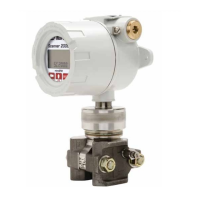9
Scanner
®
2000 microEFM Section 1
NuFlo Cone Meter (DP Input). The Scanner 2000 supports steam measurement using industry-recognized
algorithms identied in the NuFlo Cone Meter User Manual. Fluid properties for steam are calculated
in accordance with the IAPWS Industrial-Formulation 1997 (IF-97) standard. Temperature is calculated
according to IF-97 for saturated steam, based on static pressure. Therefore, an RTD is not required. The
optional Steven wet correction method is supported for the measurement of vapor and uid.
Averaging Pitot Tube Meter (Annubar
®
). The Scanner 2000 supports steam measurement based on ASME
MFC-12M -2006 ow rate methods for averaging pitot tube meters. Fluid properties are calculated in
accordance with the IAPWS Industrial-Formulation 1997 (IF-97) standard. Temperature is calculated
according to IF-97 for saturated steam, based on static pressure. Therefore, an RTD is not required. Wet
correction methods are not supported.
Compensated Liquid
The Scanner 2000 measures compensated petroleum liquid ow using an orice, cone, liquid turbine, or
averaging pitot tube (Annubar
®
) owmeter. Users can select either of two uid property calculation methods
for use with any of these owmeters.
• The “generic” uid properties calculation method is used to measure liquids such as water or emulsions,
based on user-supplied viscosity values and either user-supplied density values or user-supplied liquid
thermal expansion coefcients.
• The API-2540 calculation method provides temperature corrections for the following petroleum liquids:
crude oil, gasoline, jet fuel, fuel oils, and lube oil.
Orice Plate (DP Input). The Scanner 2000 calculates ow rates in accordance with AGA Report No. 3, Part
1 (1990) or ISO-5167 (2003) methods. When measuring liquids, the expansion factor (Y) is always equal to
1.0. Fluid property calculations for temperature-compensated measurements are based on API-2540 (1980),
Petroleum Measurement Tables.
NuFlo Cone Meter (DP Input). The Scanner 2000 calculates ow rates in accordance with industry-
recognized algorithms identied in the NuFlo Cone Meter User Manual. When measuring liquids, the
expansion factor (Y) is always equal to 1.0. Fluid property calculations for temperature-compensated liquids
are based on API-2540 (1980), Petroleum Measurement Tables.
Liquid Turbine Meter (Frequency Input). The Scanner 2000 calculates ow rates in accordance with the
measurement principles upon which the AGA-7 standard is based. The user supplies a linear or multi-point
calibration factor, and the instrument performs the required compensation calculations, based on the RTD
input.
Averaging Pitot Tube Meter (Annubar
®
). The Scanner 2000 calculates ow rates in accordance with the
ASME MFC-12M-2006 measurement standard. When measuring liquids, the expansion factor (Y) is always
equal to 1.0. Fluid property calculations for temperature-compensated liquids are based on API-2540 (1980),
Petroleum Measurement Tables.
Uncompensated Liquid
The Scanner 2000 measures uncompensated liquid ow based on the input from a liquid turbine or PD meter.
Liquid Turbine Meter (Frequency Input) or PD Meter (Pulse Input). The Scanner 2000 calculates ow rate
from a liquid turbine meter via a frequency input, or from a contact closure (which requires the pulse input on
the optional expansion board). Flow rates and totals are calculated using a user-supplied linear or multi-point
calibration factor in accordance with API Manual of Petroleum Measurement Standards, Chapter 5, Section 3,
Measurement of Liquid Hydrocarbons by Turbine Meters (2005).

